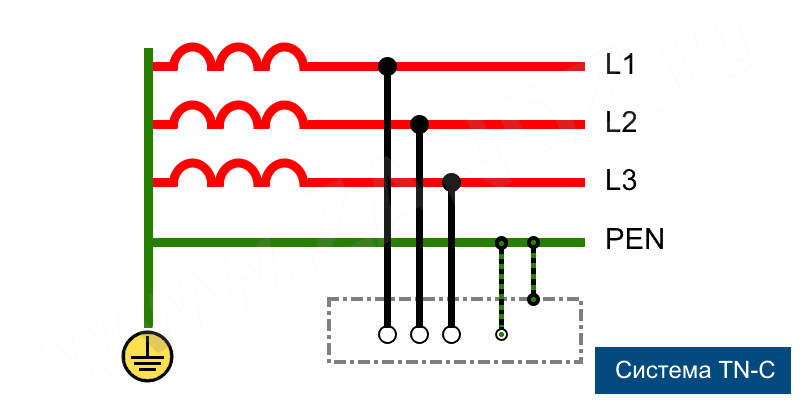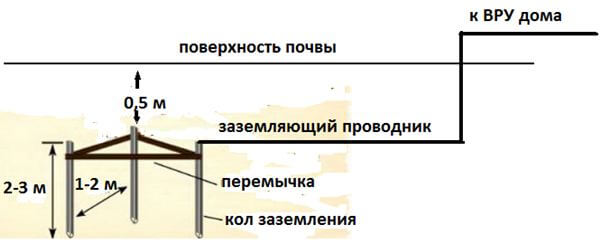What is the TN-C-S Grounding System
Existing Grounding Systems
In the electricity networks serving the housing stock, the following apply types of grounding systems:
- TN-C
- TN-S
- TN-C-S
- TT
- IT
TN-C. Outdated, but the most common system. The lion's share of the private sector and the obsolete housing stock of apartment buildings uses this type of power supply. With system TN-C the grounding circuit is equipped at the transformer step-down substation serving the house or the street, the zero point of the transformer is tightly grounded. A conductor connected to the PEN zero point is fed into the housing and functions as a zero working N and a protective conductor PE. Due to the fact that the TN-C is the simplest and most economical, it does not fully meet the requirements of electrical safety.
TN-S. In this case, the zero PN and protective PE conductors are made separately. This type of protection fully provides safety measures against electric shock, therefore, when organizing the power supply of new microdistricts, it is usedTN-S system.
Systems TT and IT are used in special conditions, we will talk about them in separate articles. Now let's take a closer look at the pros and cons, as well as what the TN-C-S system is like.
Description of power supply TN-C-S
The transfer of housing supply energy from the TN-C system to TN-S is currently not feasible, because it will require enormous modernization costs. To ensure appropriate electrical safety standards, the TN-C-S system, which is a combination of TN-C and TN-S, is the best option.
Its meaning is that from the substation to the input switchgear (ASU) at home or cottage, electricity is supplied using a single PEN conductor. In water distribution devices (ASL) of entrances or private houses equipped with re-grounding, PEN is divided into zero PN and protective conductor PE.
According to the scheme provided below, when grounding the TN-C-S type, 4 conductors are connected to the terminals of the three-phase load consumers, 3 of which are phase conductors A, B, C, and the fourth is a neutral PN wire.
The protective conductor PE is made in the form of a jumper between the metal housing of the electrical appliance and the grounding circuit. The consumer is connected to a single-phase network by a single phase wire and PN neutral, followed by grounding of the housing made of metal.
The separation scheme of the PEN conductor in the ASU:
It is very important to observe the required cross-section of the grounding conductor between the grounding circuit and the grounding busbar of the house. According to paragraph 1.7.117 (see Chapter 1.7), the grounding conductor connecting the ground electrode of the working (functional) grounding to the main grounding bus in electrical installations with voltage up to 1 kV, must have a cross-section of at least: copper - 10 mm2, aluminum - 16 mm2, steel - 75 mm2.
How to make a ground loop
In apartment buildings, specialized enterprises are usually involved in the transition to the TN-C-S grounding system. They make the appropriate switch to the ASU of the house or entrance and equip an additional grounding circuit. Practice shows that there are cases when illiterate in matters of electrical engineering, but not excessively active residents, try to modernize the power supply circuit for their individual apartment on their own. For this purpose, they try to use the risers of the water supply or heat supply as an earthing circuit, which is strictly prohibited, because This method inevitably leads to electrical injuries and has a detrimental effect on the service life of pipelines and heating appliances.
For the conditions of a private house, it is not difficult to make additional grounding, the most popular and reliable is a closed circuit in the form of a triangle:
The electrode immersed in the ground is angle steel, the jumper is a steel strip, the grounding conductor is a steel bar. More about how to make grounding in the houseWe talked in a separate article!
Advantages and disadvantages of TN-C-S
Grounding type TN-C-S, like other systems, has its pros and cons. Its significant advantages include simplicity and profitability, the ability to ensure the proper level of electrical safety. A serious disadvantage of the TN-C-S is that if the PEN conductor breaks in the area before separation, the PE conductor, as well as all the grounded metal housings of the electrical appliances, will be energized.
Finally, we recommend watching useful videos on the topic:
So we have provided a description of the TN-C-S grounding system. We hope that thanks to the diagrams and video, it became clear to you what this option of power supply is and how to organize it yourself.
It will be interesting to read:












It’s not clear, at first they talked about TN-C and TN-CS systems, in the video they compare the TT system with the TN subsystem. No one will allow you to use the TT (unless of course a private house), for this you will have to justify for a long time why you are not comfortable with the existing grounding system
The video is just provided for general development. This article is about the TN-C-S system.
You have a poorly disclosed topic of an additional grounding device. At first, nothing is said about him, not indicated on diagrams. And then it suddenly appears on the PEN conductor separation scheme, and you begin to tell how to make it.
And what do we think - does the TN-C-S use an additional grounding device or not?
The article is about re-grounding the PEN conductor, which is performed to improve the reliability of grounding. Repeated grounding of PEN is carried out at certain intervals of the overhead line, as well as at the entrance to the building. Repeated grounding is performed by the supplying organization. The end consumer does not mount additional grounding with the TN-C-S system. If the consumer mounts an individual ground loop, then this is the CT system. With this PEN grounding system, the mains conductor is used only as a neutral wire. This grounding system is practiced if the line of the TN-C-S system is in an unsatisfactory technical condition and the safety of the protective grounding provided for in it is not ensured.
Good afternoon.
At the moment, there is a shield on the support (connection of the construction site).
Judging by the connection (more precisely, by trying) this is TN-C-S.
As I understand it, PEN comes on the RB-80. To it N on the counter and diffs and a jumper on PE. Both sockets and re-ground are connected to the PE.
Is that right? Shouldn't PEN be coming to the future PE bus?
What to do with all this? And how to connect the house? 5 core cable? re-grounding only in a cabinet on a support?
Thanks for the very clear and helpful explanation.